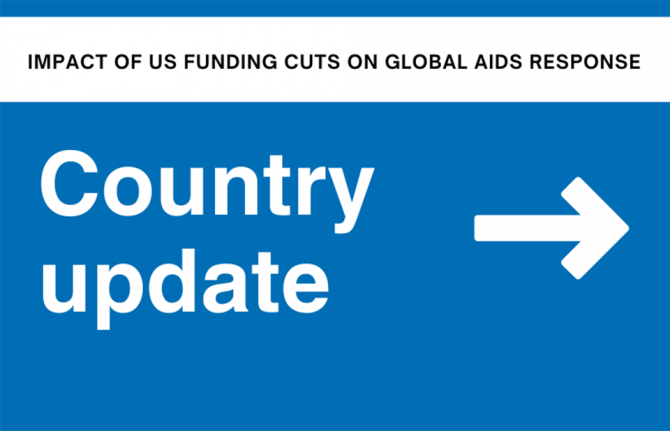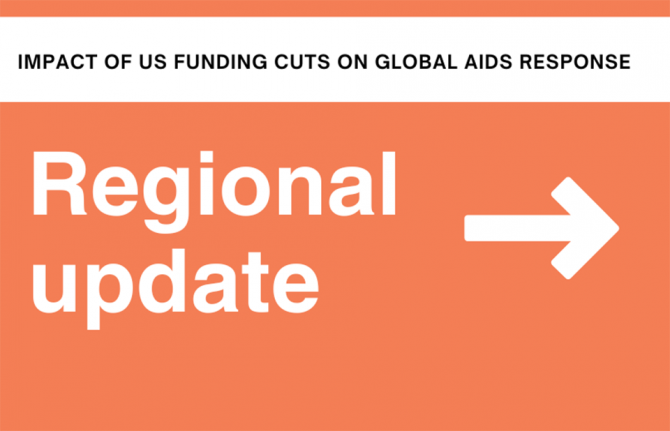
Feature Story
Progress in national AIDS response commended by UNAIDS Executive Director during official visit to Namibia
21 April 2011
21 April 2011 21 April 2011
On 20 April, UNAIDS Executive Director Michel Sidibé met with Namibian President Hifikepunye Pohamba at the State House in Windhoek. Credit: UNAIDS/T. Figueira
In a two-day official visit to Windhoek, Namibia, UNAIDS Executive Director Michel Sidibé commended President Hifikepunye Pohamba, government authorities and civil society organizations for the country’s remarkable progress in reversing the course of its AIDS epidemic.
“Namibia’s HIV response is clearly an example for other countries to follow,” said Mr Sidibé, after a meeting with President Pohamba at the State House in Windhoek on 20 April. “I applaud the Government of Namibia and its partners for the impressive results we are seeing,” he added.
Since 2001, the rate of new HIV infections in Namibia has fallen by more than 25%, especially among young people. More than 72% of Namibians who need antiretroviral treatment are now receiving it. Services to prevent vertical transmission of HIV are now reaching 75% of HIV-positive pregnant women, up from 45% in 2007.
Namibia’s HIV response is clearly an example for other countries to follow. I applaud the Government of Namibia and its partners for the impressive results we are seeing
Michel Sidibé, UNAIDS Executive Director
In his discussions with Mr Sidibé, President Pohamba expressed concerns over long-term and predictable funding for AIDS in Namibia. He called for strong national ownership of the HIV response to ensure its sustainability. Namibia’s Head of State also stressed the critical importance of strengthening HIV prevention and education programmes to achieve the country’s universal access targets.
Later in the day, the UNAIDS Executive Director hosted a lunch meeting for Ministers of Heath from across the African continent and other leaders in the HIV response, including African Union Commissioner Bience Gawanas and Michel Kazatchkine, Executive Director of the Global Fund to Fight AIDS, Tuberculosis and Malaria.
Mr Sidibé called on his guests to mobilize Heads of State and other leaders at the highest level to attend this year’s General Assembly High Level Meeting on AIDS at the United Nations in New York. The meeting, from 8-10 June 2011, will be an important opportunity to review progress in the global HIV response and chart a course for the way forward.
Pivotal role of civil society
On 19 April, Mr Sidibé congratulated civil society in Namibia for the pivotal role it played in the removal of travel restrictions for people living with HIV, which the government lifted in July 2010. He also emphasized the importance of leveraging the private sector in a more dynamic manner to widen access to HIV services for all in need.
Unless we address most-at-risk populations in Namibia, efforts to address HIV will fall short
Linda Baumann, Executive Director of Outright Namibia
Members of civil society raised a number of concerns, including coerced sterilization of people living with HIV in hospitals, discrimination against HIV-positive people in the military, lack of access to HIV services in prisons and inadequate focus on populations at higher risk of HIV infection, such as sex workers, men who have sex with men, and sexual minorities.
“Unless we address most-at-risk populations in Namibia, efforts to address HIV will fall short,” said Linda Baumann, Executive Director of Outright Namibia, a non-governmental organization that advocates for the rights of lesbian, gay, bisexual, transgender and intersex populations in Namibia.
Preventing vertical transmission of HIV
Mr Sidibé also visited a maternity and paediatric ward at the Katutura Hospital in Windhoek that is working to improve the health of women living with HIV and prevent new HIV infections among their children.
Between 2002, when the clinic first opened its doors, and 2010, the percentage of pregnant women who received HIV testing and counselling before and after delivery increased from 4.6% to 91%. By 2010, nearly 97% of infants born at the clinic were HIV-negative.

UNAIDS Executive Director Michel Sidibé talks with Petrus Johannes at the Katutura Hospital in Windhoek, Namibia. Petrus’ mother, Saima Andreas, received antiretroviral prophylaxis at the hospital during her pregnancy and, as a result, her son was born HIV-negative. Credit: UNAIDS/T. Figueira
While touring the clinic, Mr Sidibé met Saima Andreas, a 29-year-old woman who was diagnosed with HIV in 2007. Saima received antiretroviral prophylaxis during her pregnancy and gave birth last year to a child free of HIV infection. “The services I received at Katutura Hospital have given both me and my child a new lease on life,” she told Mr Sidibé. “I want to thank the government and staff at this clinic for supporting people living with HIV, especially mothers,” she added.
Despite the clinic’s success in preventing new HIV infections among children, many challenges remain, including high patient load, weak follow-up systems for mothers and infants, and poor engagement of men.
“I urge all men to support our programme to reduce the rate of HIV transmission to children in Namibia,” said Sister Carolina Visagie, a nurse at the clinic. “Our programme suffers because men do not fully support it,” she added.
Currently, only 5% of male partners of pregnant women enrolled in the clinic have been tested for HIV. In March 2011, the First Lady of Namibia launched a campaign to encourage male involvement in the prevention of new HIV infections in children.
Related
 “Who will protect our young people?”
“Who will protect our young people?”

02 June 2025
 Impact of US funding cuts on HIV programmes in Uganda
Impact of US funding cuts on HIV programmes in Uganda

19 March 2025

